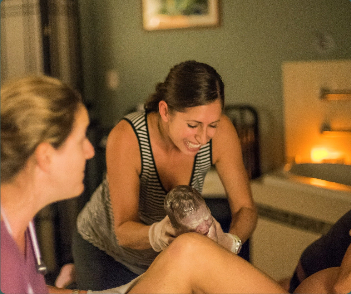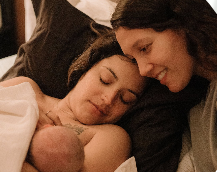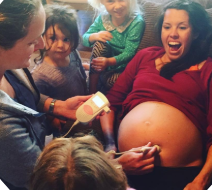Holding Space for Community and Families: the Santa Barbara Birth Centre

Tucked away in a small coastal town in California, United States of America, we find the Santa Barbara Birth Centre, a non-profit birth centre that regularly weathered health sector challenges and has also become a centre for the community, and offered a helping hand to families displaced by the Southern California Fires that raged in early 2025.
Santa Barbara Birth Centre Director Laurel Philips and midwife Beth Lang, for invited us into their space and shared insights on running and working a community-based birth centre.

Keeping their Doors Open Despite Challenges
 Founded in 2011, the Santa Barbara Birth Centre is celebrating its 14th year—an impressive feat in a sector where the average lifespan of a birth centre is just five years. “Over the past four years, eighteen birth centres have closed in California,” says the centre’s owner, Laurel Phillips, who is now focused full-time on leading the organisation as its Director. “We’re doing our best. We are a non-profit organisation, so we’ve managed to stay open partly through fundraising. We also fundraise so that we can have a subsidy fund to make our services accessible to people who cannot afford to pay for them, since we are not part of the insurance system.”
Founded in 2011, the Santa Barbara Birth Centre is celebrating its 14th year—an impressive feat in a sector where the average lifespan of a birth centre is just five years. “Over the past four years, eighteen birth centres have closed in California,” says the centre’s owner, Laurel Phillips, who is now focused full-time on leading the organisation as its Director. “We’re doing our best. We are a non-profit organisation, so we’ve managed to stay open partly through fundraising. We also fundraise so that we can have a subsidy fund to make our services accessible to people who cannot afford to pay for them, since we are not part of the insurance system.”
The primary challenge? Sustainability. As a nonprofit organisation that operates outside the traditional insurance system, the centre relies on fundraising to provide care that’s both high-touch and high-quality. “Insurance doesn’t reimburse at a sustainable rate,” Laurel explains. “Midwives spend hours with clients. Insurance reimbursement is based on the obstetric model, where the funding is distributed differently, and doesn’t cover that additional time that is a critical part of midwifery care.”
Laurel and her team have also been involved in important advocacy at the state level in California, to ensure that midwifery care is covered by state insurance, “If we want to make sure that people can affordably access our care, and that we are fairly paid for our work, we need to work with policymakers to find models that work.”
Midwives, Births, and the Power of Continuity
Staffed by three full-time, and one part-time midwife, the birth centre serves around 85 to 110 clients each year. About 60% of births take place at the Centre, while 40% happen at home—a balance that reflects growing trust and comfort among clients. First-time parents often start at the centre and opt for home birth with subsequent children.
“Everyone is still coming to the birth centre for the majority of their antenatal care. And then everyone gets all their postnatal care at home. Whether they give birth at home or at the Birth Centre, the midwives are going to them in their home for four postnatal visits, which is really one of the keystones of our care.” This includes home visits on days one, three and five, and again in the second week—plus a six-week follow-up at the BCrth Centre. These 90-minute home visits typically include mother and baby checks, “We want them to go home, get in bed, and stay there basically for two weeks.”
More Than Just Birth
The Centre also offers well-woman care, offering holistic care across the midwifery scope of practice. “It’s a full midwifery model kind of care for annual exams, screenings or preconception care. Teenagers, perimenopause, menopause.” Laurel emphasises that the model of care remains deeply rooted in the midwifery philosophy of care, being very gentle, very time intensive, trauma-informed, with an emphasis on consent, “It’s not your typical pap smear,” she explains. “It’s slow and gentle, and permission is always asked first. That’s huge for people who’ve had negative experiences in medical settings.”
But what truly sets the BCrth Centre apart is its deep community engagement. Their community room buzzes with activity: free prenatal and postpartum groups, childbirth education classes, breastfeeding support, guest speakers on infant sleep, perinatal mood disorders, pelvic floor health, and more. “The idea is to create a soft landing,” she says, “so you are in the antenatal group and just roll right into the postnatal group, building community and a sense of belonging. It makes it so much easier to adapt when you have a group to adapt with.”
Beyond the Birth Room: Outreach and Education
While most clients find the centre through word of mouth, the team is working to reach a broader audience—including those who don’t even know such care exists. “People often come to us in their third trimester saying, ‘I wish I’d known about you earlier.’ That’s what we’re trying to change.”
Their solution? Education. They visit high school health classes, host college students, and give lectures to future healthcare professionals. “Most students had no idea midwifery care could be so safe and connected. It blows their minds.”
The goal is clear: reach people early, before they’re pregnant, and let them know they have choices. “If you hear about this kind of care at 16,” she says, “you might remember it when you’re 26,” Laurel explained.
A Refuge in Times of Crisis
When wildfires displaced families in Southern California in early 2025, the Birth Centre became a haven. “A midwife from Los Angeles called to ask if we could take her client who was relocating here. We said yes—three weeks before her due date.”
In another case, a pregnant woman fleeing the fires arrived devastated. Her home had burned down. One of the midwives met her on a Saturday. “They cried together. Took blood pressure. Just sat with her. It’s what midwives do—offer care and comfort in chaos.”
These moments underscore the unique role midwives play in not just physical health, but emotional healing and community rebuilding.
The Future of Birth is Personal
At its core, the Santa Barbara Birth Centre isn’t just about delivering babies. It’s about holding space—literally and metaphorically—for women and families navigating life transitions.
It’s about providing an alternative to the technocratic medical system that so often overlooks the human side of care. And it’s about teaching the next generation—whether through hands-on care, community groups, or classroom talks—that birth can be empowering, gentle, and shared.
As birth centre Director Laurel concludes, “Midwives build community. We support each other, our clients, and those who’d love to provide care but can’t due to circumstance. It’s about making room—for people, for healing, and for possibility.”